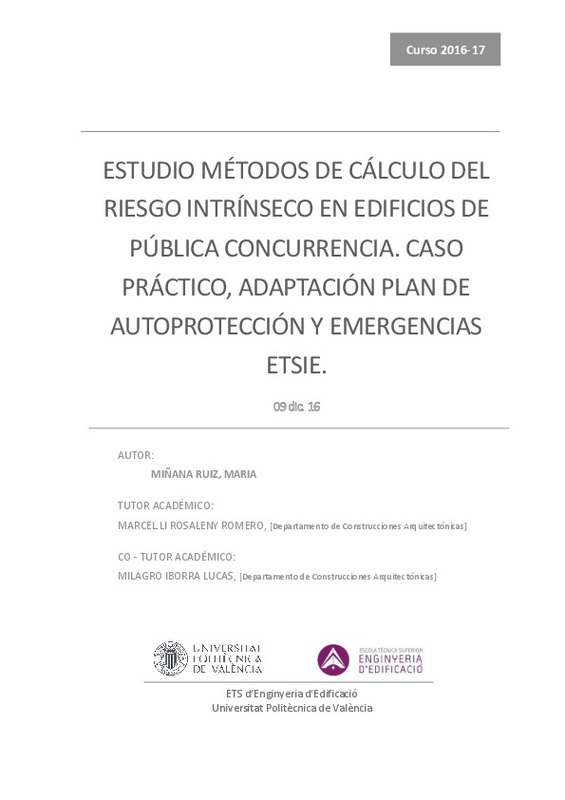|
Resumen:
|
[ES] El objetivo de este Trabajo Fin de Grado (en adelante TFG) es analizar los diferentes métodos de cálculo de riesgo de incendio que se emplean para estimar el riesgo intrínseco existente en edificios de pública ...[+]
[ES] El objetivo de este Trabajo Fin de Grado (en adelante TFG) es analizar los diferentes métodos de cálculo de riesgo de incendio que se emplean para estimar el riesgo intrínseco existente en edificios de pública concurrencia. Este trabajo consta de tres partes: en la primera se analizan y desarrollan los métodos de cálculo de riesgo de incendio; en la segunda, éstas metodologías se aplican de manera práctica al edificio de la ETSIE (Escuela Técnica Superior de Ingeniería de la Edificación); y en la tercera y última parte, se desarrolla el Plan de Autoprotección y Emergencias también para la ETSIE. La primera fase de la elaboración de este trabajo, fue de investigación acerca de los métodos en publicaciones técnicas, revistas especializadas, información telemática contrastada en internet, etc. Con esta información se optó por aplicar un método ágil y dinámico para aplicar a la ETSIE. Se incorpora al TFG el cálculo de las diferentes áreas, dependencias y sectores susceptibles de incendio. La tercera parte del TFG recoge la aplicación práctica de un Plan de Autoprotección y Emergencias, que a petición de mis tutores, se ha realizado de nuevo en el edificio de la ETSIE. Ha sido un trabajo muy interesante ya que se daba la singularidad de tratar en un mismo Plan dos edificios de la misma escuela, con diferentes normativas de aplicación de Protección de Incendios. El objetivo fundamental de los Planes de Autoprotección es proteger a los usuarios frente a los diversos riesgos y prevenir daños en los edificios o establecimientos próximos. Por tanto, se propone que el plan de actuación ante emergencias dé una respuesta rápida y segura ante cualquier imprevisto, teniendo en cuenta que en el edificio se desarrollan varias actividades dentro del uso docente en general, además de integrarse en el edificio otros usos, como restaurante, laboratorios y oficinas. Para la elaboración de este trabajo se ha seguido la normativa vigente, incluyendo la Ley 2/1985, de 21 de enero, sobre Protección Civil, que contempla los aspectos relativos a la autoprotección, determinados en sus artículos 5 y 6; y el Real Decreto 393/2007, de 23 de marzo, que sirve de guión para la elaboración del Plan de Autoprotección y la Norma Básica de Autoprotección de los centros, establecimientos y dependencias dedicados a actividades que puedan dar origen a situaciones de emergencia, que da las soluciones técnicas necesarias para evacuar el edificio.
[-]
[EN] The purpose of this Final Degree Thesis (TFG from now on) is to analyse the different methodologies of fire risk calculation, which are used to estimate the existing inherent risk in public audience buildings. The ...[+]
[EN] The purpose of this Final Degree Thesis (TFG from now on) is to analyse the different methodologies of fire risk calculation, which are used to estimate the existing inherent risk in public audience buildings. The Thesis consists of three parts: in the first one, fire risk calculation methodologies are analysed and developed; in the second one, these methodologies are applied, having chosen the ETSIE building as a practical case study; in the third part, the Self-Protection and Emergency Plan is developed for the ETSIE too. There was a first phase in the development of this Thesis, consisting of researching about the ethodologies in technical publications, specialised magazines, verified telematics information found on the Internet, etc. With this information a streamlined and dynamic methodology is to be applied to the ETSIE. The calculation of the different areas, units and fire sectors are included in the TFG. The third part of the TFG consists of the application in practice of the Self-Protection and Emergency Plan, which has been again developed for the ETSIE, at the request of my tutors. It has been a very interesting work, because this is a singular case in which a single Plan omprises two different buildings of the same school, with different fire regulations to be applied on each of them. The main purpose of the Self-Protection Plans is to protect the users against the different risks and to prevent damages in the given buildings, as well as in close ones. Therefore, the action plan needs to give a quick and safe response to any foreseen event, taking into account that different activities are carried out in the building apart from the educational ones, including a restaurant, laboratories and offices. To carry out this work, the current regulation has been followed, including the Law 2/1985 from the 21st of January about Civil Protection, which contemplates the matters relating to self-protection, set in the articles 5 and 6; and the Royal Decree-Law 393/2008 from the 23rd of March, which serves as a script for the elaboration of the Self-Protection and Basic Standard of Self-Protection for centres, establishments and units dedicated to activities that can lead to emergency situations, which gives technical solutions to evacuate the building.
[-]
|







